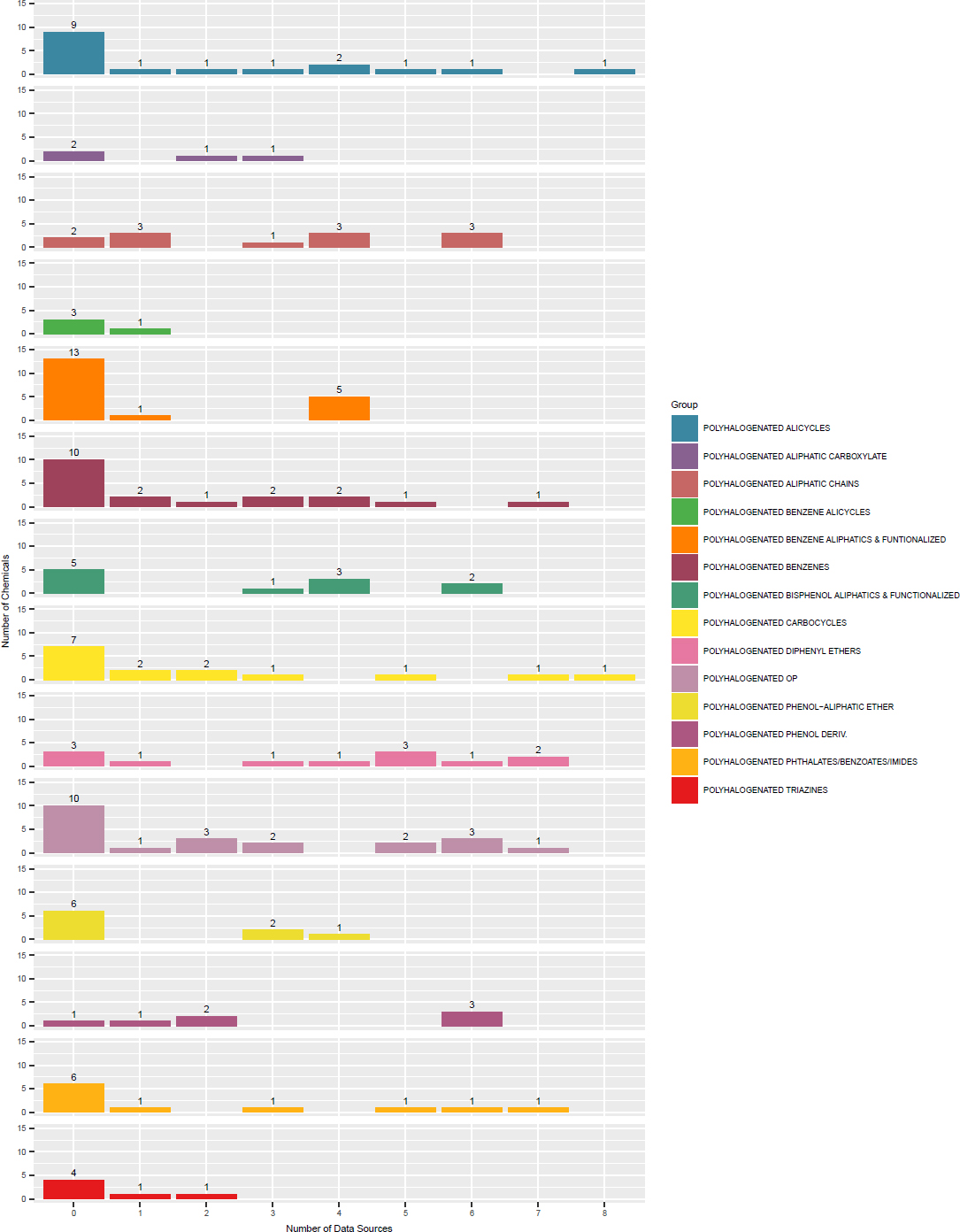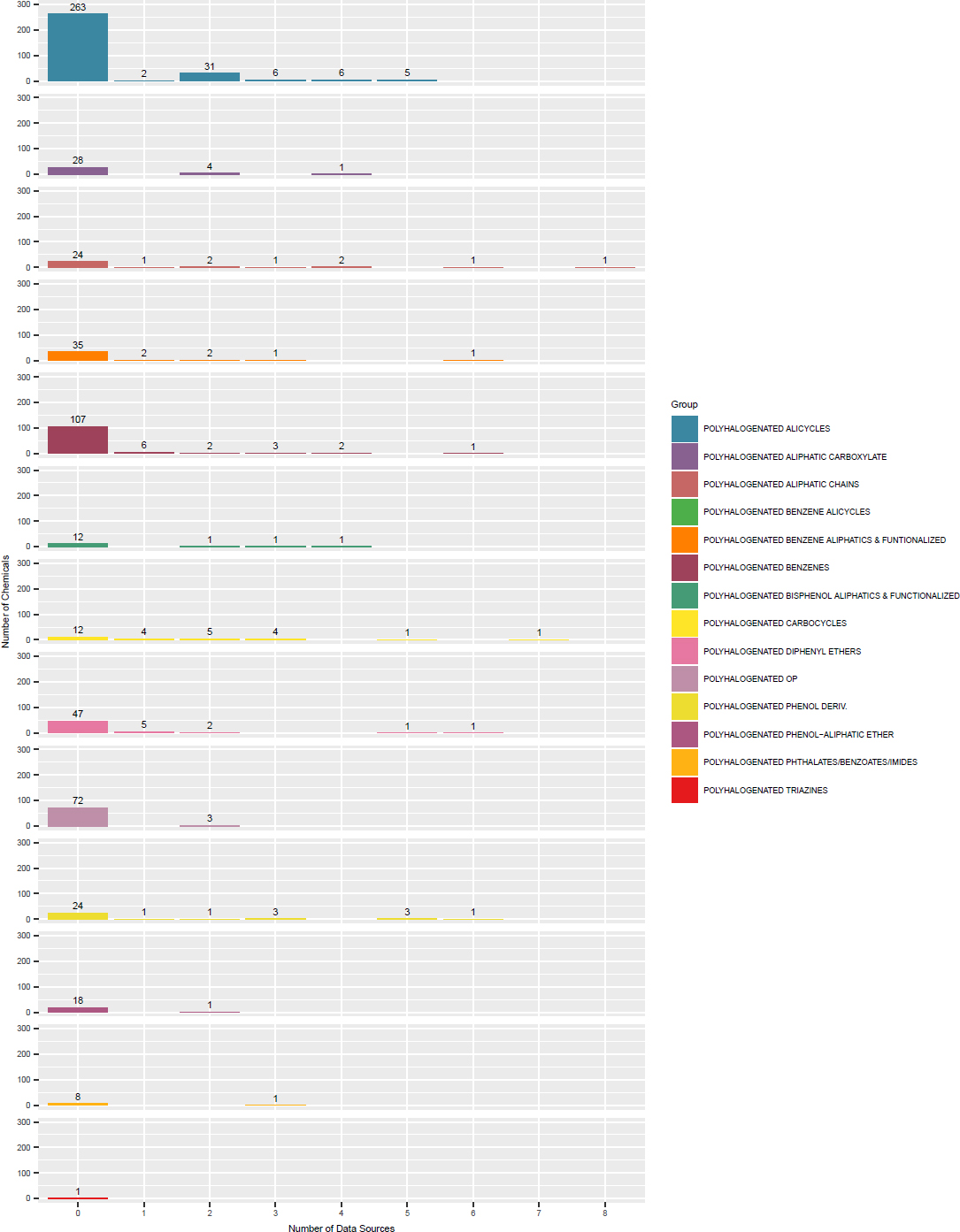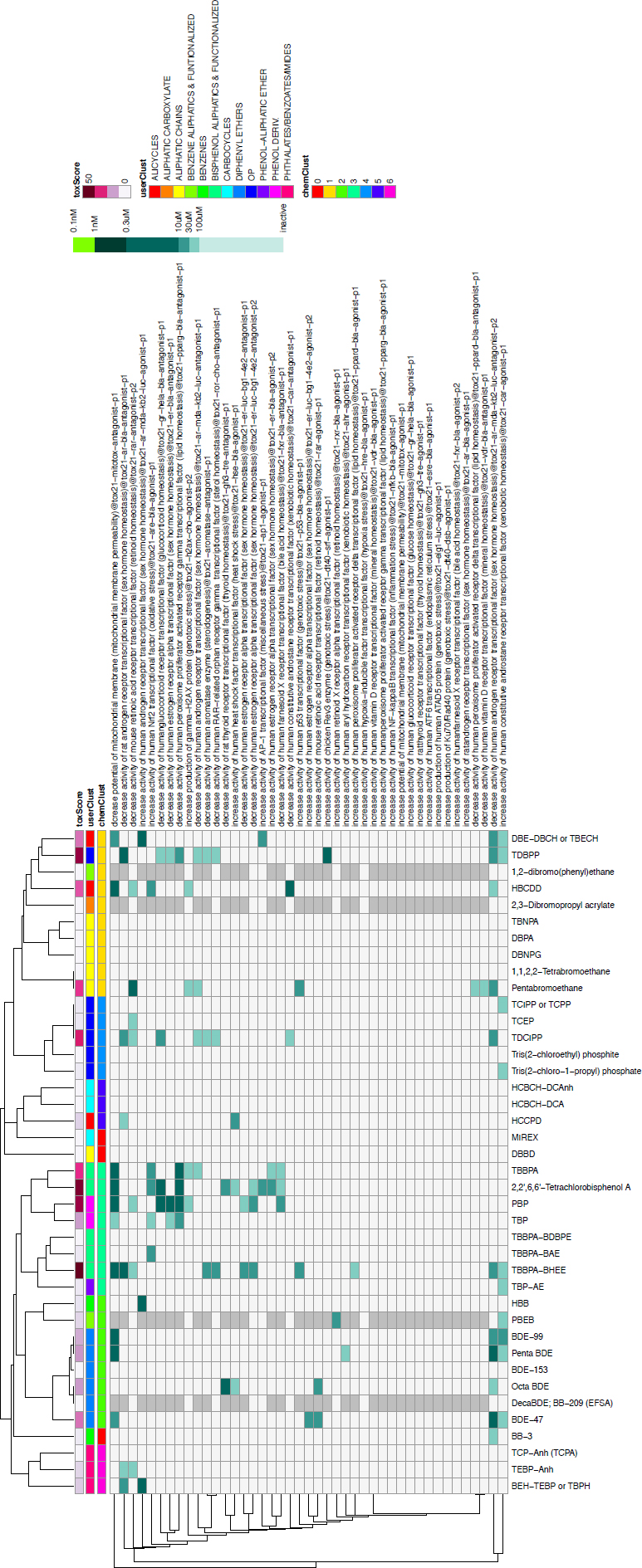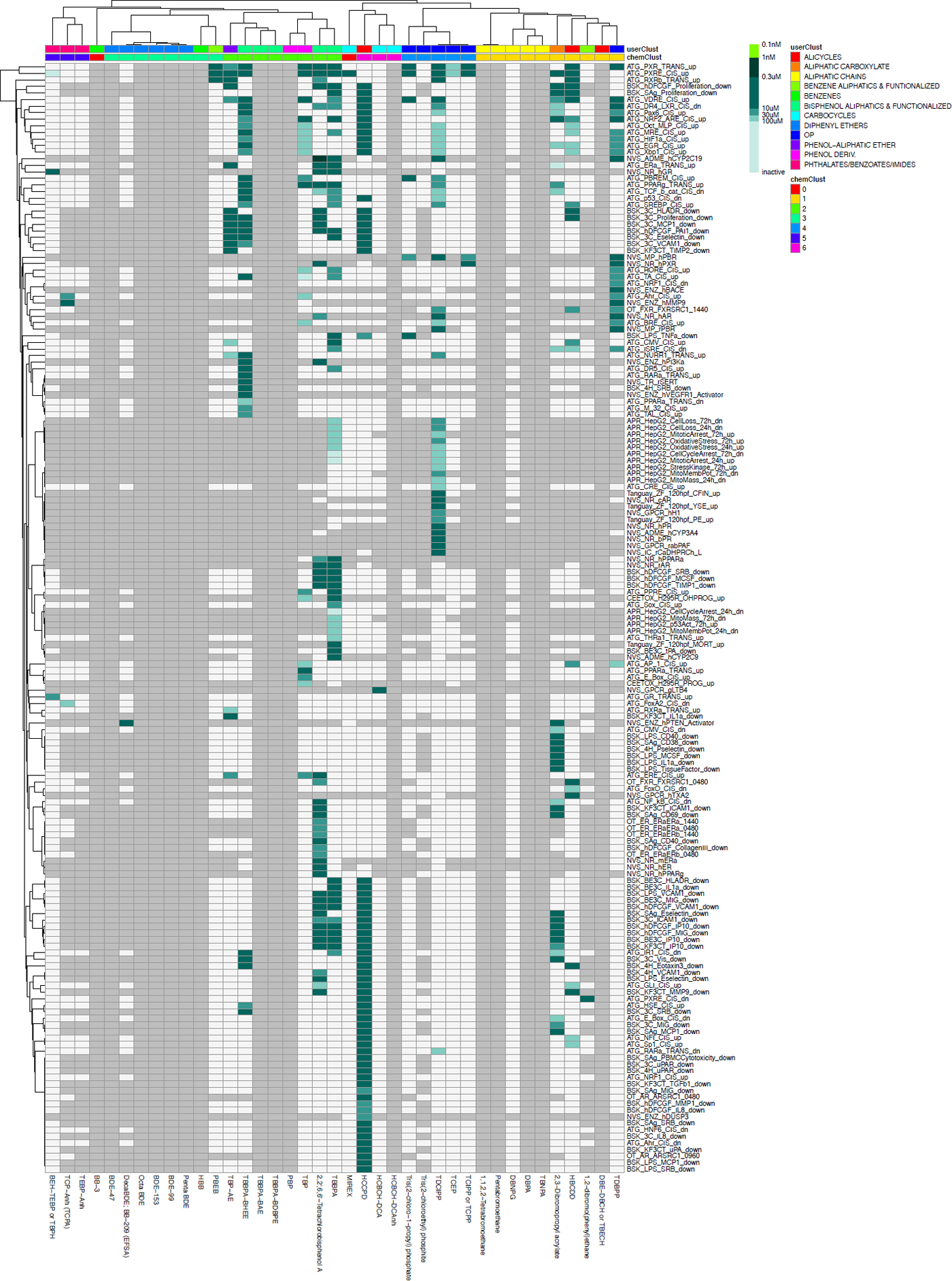C
Methodologic Details of Literature Surveys and Searches
The committee conducted several exercises associated with the literature surveys and searches that are described in Chapter 3. This appendix provides the methodologic details of those exercises.
ASSESSING THE AVAILABILITY AND ACCESSIBILITY OF BIOLOGIC DATA
The committee performed several analyses to identify case studies on the basis of available biologic data. It assessed and compared the coverage and distribution of data on the inventory of organohalogen flame retardants (OFRs) and the expanded set of chemicals. In this context, coverage is defined as the availability of data on given chemicals or chemical subclasses in bioinformatically mappable databases (Figures C-1, C-2, and C-3). The use of publicly available databases is a reproducible example of querying accessible data on a generic chemical set. The analysis is likely biased toward high-throughput and other new approach methodologies (NAM) data. The case examples described in Chapter 3 built on this initial survey of data availability by including additional published data on the two subclasses of interest.
The results that support the analyses are provided in a supplemental file, 20190118_DataGroupSplit.csv.1 The chemical lists used were those generated to create the inventory and the expanded chemical set.2 For the data mapping, CAS registry numbers, rather than SDF (structural) information, were used. The seven chemicals assigned to two groups are plotted twice in preceding data-survey figures. Each data resource was queried separately, as detailed below.
- Comparative Toxicogenomics Database (CTD). Chemicals were queried in the CTD. Results of the batch queries were output in JSON format and read into R as a text file. The text file was searched for the expression “Object not found”; negative results correspond to a chemical’s existence within the database. Chemical presence in the database was recorded as a binary variable.
- Environmental Protection Agency (EPA) Chemical Dashboard. In the EPA Chemical Dashboard, chemicals can be categorized into three groups: not in database, untested in database, and tested in database. Chemicals were first queried for the first category, not in database. Source code from the URL was extracted and searched for the expression “Found 0 results”; positive results indicated that a chemical is not in database. URLs for the remaining chemicals were then Web-scraped, and resulting content was queried for bioactivity settings. For four possible bioactivity settings, text was searched for the expression “is-disabled”. If all four sections of the Web page are disabled, the chemical is considered untested in database; otherwise, it is tested in database.
- ToxNet. The Hazardous Substances Databank and the Integrated Risk Information System were searched by using an ID tag that corresponded to each database’s specific chemical ID. If a chemical ID does not exist, the chemical is considered untested.
- ToxCast and Tox21. Data in the ToxCast database were downloaded from ftp://newftp.epa.gov/comptox/High_Throughput_Screening_Data/ToxcastdatareleaseSept2018/INVITRODBV3_20181017.zip. CAS numbers were searched against the 161 chemicals by using the R expression NASCasrn %in% ToxCastCASRN.
- Toxicity Reference Database (ToxRefDB). Data from ToxRefDB were downloaded from ftp://newftp.epa.gov/comptox/High_Throughput_Screening_Data/Animal_Tox_Data/toxrefdb%20(1).zip. CAS numbers were searched against the 161 chemicals by using the R expression NASCasrn %in% ToxRefDBCASRN.
___________________
1 The supplemental table lists all chemicals mapped to data in Figures C-1, C-2, and C-3. File available at www.nap.edu/25412.
2 See OFR_Categories_OFR-inventory_02-15-2019.xlsx and OF R_Analogs.xlsx. Files available at www.nap.edu/25412.



- ChEMBL. CAS numbers are converted to ChEMBL identifiers. If a ChEMBL ID exists, the chemical is considered tested in ChEMBL.
- PubChem. For PubChem, chemicals can be categorized into three groups: not in database, untested in database, and tested in database. Chemicals were first queried for the first category, not in database. Source code from the URL was extracted and searched for the word “term” that exists in the resulting URL when the chemical is not in database. For the remaining chemicals, PubChem IDs are extracted and searched by using rpubchem::get. aid.by.cid(). That function returns assay IDs for tested chemicals, so chemicals with no associated assays are considered untested in database; otherwise, they are tested in database.
SEARCHING THE TOX21 AND TOXCAST DATA
Figures C-4 and C-5 provide a summary of Tox21 and ToxCast data, respectively. The following methods were used to query for those data.
- Tox21 data. The Tox21 Activity Profiler (https://sandbox.ntp.niehs.nih.gov/tox21-activity-browser/) was accessed on Nov. 19, 2018 to retrieve activity data on chemicals that were tested in Tox21 from the list of 161 chemicals in the OFR inventory. Activity data on 40 chemicals with acceptable analytic chemistry data or those still under analytic analysis were available for 43 toxicity end points. The log10-transformed point-of-departure (POD) activity results are presented as a heatmap. Chemicals judged to be inactive or inconclusive are represented as light gray. Dark gray in a cell indicates that the chemical was not tested in that assay. Green indicates activity, with the approximate POD concentration indicated in the key. The column and row arrangement on the heatmap is based on the results of hierarchic clustering (dendrograms). The clustering of columns is based on chemical-structure similarity (defined by Leadscope® structural fingerprints and Tanimoto coefficient); the clustering of rows is based on activity similarity according to Euclidean distance. The chemicals are also annotated on the basis of “ToxScore”, “userClust”, and “chemClust” (the three rows above the heatmap). The userClust is the chemical-structure category; the ToxScore is the sum of log10-transformed POD values, and chemClust is the chemical groupings based on chemical-structure similarity within a chemical class.
- ToxCast data. Activity data from ToxCast assays were accessed on Nov 19, 2018 (https://figshare.com/articles/ToxCast_and_Tox21_Summary_Files/6062479, version 2). Activity data were retrieved for 39 compounds on which there were acceptable analytic-chemistry data or those still under analysis of the 161 chemicals in the OFR inventory for 171 assay end points. The log10-transformed POD activity results are presented as a heatmap. Chemicals judged to be inactive or inconclusive are represented as light gray. Dark gray in a cell indicates that the chemical was not tested in the assay. Green indicates activity, with the approximate POD concentration indicated in the key. The column and row arrangements on the heatmap are based on the results of hierarchic clustering (dendrograms). The clustering of columns is based on chemical-structure similarity (defined by Leadscope® structural fingerprints and Tanimoto coefficient); the clustering of rows is based on activity similarity according to Euclidean distance. The chemicals are also annotated on the basis of “ToxScore”, “userClust”, and “chemClust” (the three rows above the heatmap). The userClust is the chemical-structure category, the ToxScore is the sum of log10-transformed POD values, and chemClust is the chemical groupings based on chemical-structure similarity within a chemical class.
LITERATURE SEARCHES
Literature searches described in Chapter 3 for the two case studies depended on searches for English language, peer-reviewed literature in two databases: PubMed and PubChem. The searches were designed and performed by a librarian trained in systematic review methods. The searches used the following terms:
Chemical-specific terms for polyhalogenated bisphenolaliphatics
- “Tetrabromobisphenol A bis(2-hydroxyethyl) ether bis(acrylate)” OR “Bis(p-acryloxyethoxy)tetrabro mobisphenol A” OR “Tetrabromobisphenol A bis (2-hydroxyethyl)” OR “Ethoxylated Tetrabromo Bisphenol A Diacrylate” OR “66710-97-2” OR “TBB PA-BHEEBA”
- “2,2’,6,6’-Tetrabromobisphenol A diacrylate” OR “Tetrabromobisphenol A diacrylate” OR “55205-38-4” OR “TBBPA-BA”
- “Tetrabromobisphenol A bismethyl ether” OR “tetrabromobisphenol A dimethyl ether” OR “37853-61-5” OR “TBBPA-BME”
- “37419-42-4” OR “TBBPA-BP”
- “Tetrabromobisphenol A Diglycidyl Ether” OR “3072-84-2” OR “TBBPA-BGE”
- “4,4’-Isopropylidenebis(2,6-dibromophenyl) diacetate” OR “33798-02-6” OR “TBBPA-BOAc”
- “Tetrabromobisphenol A” OR “79-94-7” OR “TBBPA”
- “Tetrabromobisphenol A diallyl ether” OR “25327-89-3” OR “TBBPA-BAE”
- “Tetrabromobisphenol A dibromopropyl ether” OR “Tetrabromobisphenol A bis(dibromopropyl ether)” OR “21850-44-2” OR “TBBPA-BDBPE”
- “Ethoxylated tetrabromobisphenol A” OR “Tetrabromobisphenol A bis(ethoxylate)” OR “4162-45-2” OR “TBBPA-BHEE”
- “Tetrachlorobisphenol A” OR “Tetrachlorodian” OR “79-95-8” OR “TCBPA”
Chemical-specific search terms for polyhalogenated organophosphates
- “Tris(2,3-dibromopropyl) phosphate” OR “TDBPP” OR “126-72-7”
- “19186-97-1”
- “Tris(2-chloroethyl) phosphate” OR “Trichlorethyl phosphate” OR “2-Chloroethanol phosphate” OR “115-96-8”
- “Tris(1-chloropropan-2-yl) phosphate” OR “Tris(1chloro-2-propyl) phosphate” OR “Tris(2-chloro-1-methylethyl) phosphate” OR “13674-84-5”
- “Tris(1,3-dichloro-2-propyl)phosphate” OR “Tris (1,3-dichloroisopropyl)phosphate” OR “TDCPP” OR “13674-87-8”
- “2,2-Bis(chloromethyl)-1,3-propanediyl bis(bis(2chloroethyl) phosphate)” OR “38051-10-4”
- “Bis(1,3-dichloro-2-propyl)-3-chloro-2,2-dibromomethyl-1-propyl phosphate” OR “2,2-Bis (bromomethyl)-3-chloropropyl bis(2-chloro-1(chloromethyl)ethyl) phosphate” OR “K6UU3AT 81T” OR “66108-37-0”
- “Tris(2,3-dichloropropyl) phosphate” OR “2,3-Di-chloro-1-propanol phosphate” OR “78-43-3”
- “Tris(2-chloropropyl) phosphate” OR “Tris(beta-chloropropyl) phosphate” OR “6145-73-9”
TABLE C-1 Number of Results of the PubChem Database Search
| Query | Results* |
|---|---|
| Polyhalogenated bisphenol aliphatics | |
| "66710-97-2"[CompleteSynonym] | 0 |
| "55205-38-4"[CompleteSynonym] | 0 |
| "37853-61-5"[CompleteSynonym] | 5 |
| "37419-42-4"[CompleteSynonym] | 0 |
| "3072-84-2"[CompleteSynonym] | 3 |
| "33798-02-6"[CompleteSynonym] | 0 |
| "79-94-7"[CompleteSynonym] | 688 |
| "25327-89-3"[CompleteSynonym] | 0 |
| "21850-44-2"[CompleteSynonym] | 2 |
| "4162-45-2"[CompleteSynonym] | 2 |
| "79-95-8"[CompleteSynonym] | 62 |
| Polyhalogenated organophosphates | |
| "126-72-7"[CompleteSynonym] | 342 |
| "19186-97-1"[CompleteSynonym] | 0 |
| "115-96-8"[CompleteSynonym] | 309 |
| "13674-84-5"[CompleteSynonym] | 89 |
| "13674-87-8"[CompleteSynonym] | 128 |
| "38051-10-4"[CompleteSynonym] | 1 |
| "66108-37-0"[CompleteSynonym] | 1 |
| "78-43-3"[CompleteSynonym] | 10 |
| "6145-73-9"[CompleteSynonym] | 31 |
| "33125-86-9"[CompleteSynonym] | 0 |
| "115-98-0"[CompleteSynonym] | 11 |
| "49690-63-3"[CompleteSynonym] | 2 |
| "7046-64-2"[CompleteSynonym] | 0 |
| "5412-25-9"[CompleteSynonym] | 15 |
| "140-08-9"[CompleteSynonym] | 12 |
| "4351-70-6"[CompleteSynonym] | 0 |
| "6294-34-4"[CompleteSynonym] | 4 |
| "6749-73-1"[CompleteSynonym] | 0 |
| "53461-82-8"[CompleteSynonym] | 0 |
| "61090-89-9"[CompleteSynonym] | 0 |
| "114955-21-4"[CompleteSynonym] | 0 |
| "1373346-90-7"[CompleteSynonym] | 0 |
*Total references as found in PubChem. Not necessarily related to toxicity. These are total records. The results have not been deduplicated. For a combination of chemical and toxicity, see the PubMed results in Table C-2.
- “Tetrakis(2-chloroethyl) ethane-1,2-diyl bis(phos phate)” OR “Ethylene bis(bis(2-chloroethyl)phosphate)” OR “33125-86-9”
- “Vinifos” OR “Bis(2-chloroethyl) vinylphosphonate” OR “Fyrol Bis beta” OR “115-98-0”
- “Tris(2,4-dibromophenyl)phosphate” OR “49690-63-3”
- “Phenol, 2,4,6-tribromo-, phosphate” OR “7046-64-2”
- “Bis(2,3-dibromopropyl) phosphate” OR “Bis(2,3dibromopropyl) hydrogen phosphate” OR “5412-25-9”
- “Tris(2-chloroethyl)phosphite” OR “Ethanol, 2-chloro-, phosphite (3:1)” OR “2-Chloroethanol phosphite (3:1)” OR “140-08-9”
- “Phosgard c-22R” OR “Phosgard c-22R (monsanto)” OR “4351-70-6”
- “Bis(2-Chloroethyl) (2-Chloroethyl)Phosphonate” OR “Bis(2-chloroethyl) 2-chloroethylphospho-nate” OR “6294-34-4”
- “Tris(1,3-dichloropropan-2-yl) phosphite” OR “2-Propanol, 1,3-dichloro-, phosphite (3:1)” OR “Tris(2-chloro-1-(chloromethyl)ethyl) phosphite” OR “6749-73-1”
- “Oxydiethylene tetrakis(2-chloroethyl) bisphosphate” OR “Diethylene glycol tetra(2-chloroethyl) phosphate” OR “53461-82-8”
- “UASQAKNFTHVEDR-UHFFFAOYSA-N” OR “3,9-Bis(3-bromo-2,2-bis(bromomethyl)propoxy)-2,4,8,10-tetraoxa-3,9-diphosphaspiro(5.5)un-decane 3,9-dioxide” OR “3,9-bis[3-bromo-2,2-bis(bromomethyl)propoxy]-2,4,8,10-tetraoxa-3” OR “61090-89-9”
- “114955-21-4”
- “1373346-90-7”
Specific search terms for outcomes of interest
- Toxicity OR Reproductive Toxicity OR Developmental Toxicity
- Genotoxicity OR Mutagenicity
- Cancer OR Carcinogenicity
Results (count) from the PubChem and PubMed searches are presented in Tables C-1 and C-2, respectively.
TABLE C-2 Number of Results of the PubMed Database Search
| No. | Query Terms and Searches | Results* |
|---|---|---|
| Polyhalogenated bisphenol aliphatics: Search Terms | ||
| 1 | "Tetrabromobisphenol A bis(2-hydroxyethyl) ether bis(acrylate)" OR "Bis(pacryloxyethoxy)tetrabromobisphenol A" OR "Tetrabromobisphenol A bis(2-hydroxyethyl)" OR "Ethoxylated Tetrabromo Bisphenol A Diacrylate" OR "66710-97-2" OR "TBBPA-BHEEBA" | NA |
| 2 | "2,2',6,6'-Tetrabromobisphenol A diacrylate" OR "Tetrabromobisphenol A diacrylate" OR "55205-38-4" OR "TBBPA-BA" | NA |
| 3 | "Tetrabromobisphenol A bismethyl ether" OR "tetrabromobisphenol A dimethyl ether" OR "37853-61-5" OR "TBBPA-BME" | NA |
| 4 | "37419-42-4" OR "TBBPA-BP" | NA |
| 5 | "Tetrabromobisphenol A Diglycidyl Ether" OR "3072-84-2" OR "TBBPA-BGE" | NA |
| 6 | "4,4'-Isopropylidenebis(2,6-dibromophenyl) diacetate" OR "33798-02-6" OR "TBBPA-BOAc" | NA |
| 7 | "Tetrabromobisphenol A" OR "79-94-7" OR "TBBPA" | NA |
| 8 | "Tetrabromobisphenol A diallyl ether" OR "25327-89-3" OR "TBBPA-BAE" | NA |
| 9 | "Tetrabromobisphenol A dibromopropyl ether" OR "Tetrabromobisphenol A bis(dibromopropyl ether)" OR "21850-44-2" OR "TBBPA-BDBPE" | NA |
| 10 | "Ethoxylated tetrabromobisphenol A" OR "Tetrabromobisphenol A bis(ethoxylate)" OR "4162-45-2" OR "TBBPA-BHEE" | NA |
| 11 | "Tetrachlorobisphenol A" OR "Tetrachlorodian" OR "79-95-8" OR "TCBPA" | NA |
| 12 | "toxicology"[MeSH Terms] OR "toxicity"[Title/Abstract] OR "toxicity"[Text Word] OR "developmental toxicity"[Title/Abstract] OR "developmental toxicity"[Text Word] OR "reproductive toxicity"[Title/Abstract] OR "reproductive toxicity"[Text Word] | NA |
| 13 | "toxicogenetics"[MeSH Terms] OR "toxicogenetics"[Title/Abstract] OR "toxicogenetics"[Text Word] OR "genotoxicity"[Title/Abstract] OR "genotoxicity"[Text Word] OR "mutagens"[MeSH Terms] OR "mutagenicity"[Title/Abstract] OR "mutagenicity"[Text Word] | NA |
| 14 | "neoplasms"[MeSH Terms] OR "cancer"[Title/Abstract] OR "neoplasms"[Title/Abstract] OR "tumors"[Title/Abstract] OR "cancer"[Text Word] OR "neoplasms"[Text Word] OR "tumors"[Text Word] OR "carcinogens"[Title/Abstract] OR "carcinogens"[Text Word] OR "carcinogenicity"[Title/Abstract] OR "carcinogenicity"[Text Word] OR "carcinogenic"[Title/Abstract] OR "carcinogenic"[Text Word] OR "carcinogens"[MeSH Terms] | NA |
| No. | Query Terms and Searches | Results* |
|---|---|---|
| Polyhalogenated bisphenol aliphatics: Searches | ||
| 15 | #1 AND #12 | 20 |
| 16 | #1 AND #13 | 0 |
| 17 | #1 AND #14 | 7 |
| 18 | #2 AND #12 | 0 |
| 19 | #2 AND #13 | 0 |
| 20 | #2 AND #14 | 0 |
| 21 | #3 AND #12 | 2 |
| 22 | #3 AND #13 | 0 |
| 23 | #3 AND #14 | 0 |
| 24 | #4 AND #12 | 0 |
| 25 | #4 AND #13 | 0 |
| 26 | #4 AND #14 | 0 |
| 27 | #5 AND #12 | 0 |
| 28 | #5 AND #13 | 0 |
| 29 | #5 AND #14 | 1 |
| 30 | #6 AND #12 | 0 |
| 31 | #6 AND #13 | 0 |
| 32 | #6 AND #14 | 0 |
| 33 | #7 AND #12 | 291 |
| 34 | #7 AND #13 | 4 |
| 35 | #7 AND #14 | 40 |
| 36 | #8 AND #12 | 1 |
| 37 | #8 AND #13 | 0 |
| 38 | #8 AND #14 | 0 |
| 39 | #9 AND #12 | 6 |
| 40 | #9 AND #13 | 0 |
| 41 | #9 AND #14 | 1 |
| 42 | #10 AND #12 | 2 |
| 43 | #10 AND #13 | 0 |
| 44 | #10 AND #14 | 1 |
| 45 | #11 AND #12 | 25 |
| 46 | #11 AND #13 | 0 |
| 47 | #11 AND #14 | 5 |
| Polyhalogenated organophosphates: Search Terms | ||
| 1 | "Tris(2,3-dibromopropyl) phosphate" OR "TDBPP" OR "126-72-7" | NA |
| 2 | "19186-97-1" | NA |
| 3 | "Tris(2-chloroethyl) phosphate" OR "Trichlorethyl phosphate" OR "2-Chloroethanol phosphate" OR "115-96-8" | NA |
| 4 | "Tris(1-chloropropan-2-yl) phosphate" OR "Tris(1-chloro-2-propyl) phosphate" OR "Tris(2-chloro-1-methylethyl) phosphate" OR "13674-84-5" | NA |
| 5 | "Tris(1,3-dichloro-2-propyl)phosphate" OR "Tris(1,3-dichloroisopropyl)phosphate" OR "TDCPP" OR "13674-87-8" | NA |
| 6 | "2,2-Bis(chloromethyl)-1,3-propanediyl bis(bis(2-chloroethyl) phosphate)" OR "38051-10-4" | NA |
| 7 | "Bis(1,3-dichloro-2-propyl)-3-chloro-2,2-dibromomethyl-1-propyl phosphate" OR "2,2-Bis(bromomethyl)-3-chloropropyl bis(2-chloro-1-(chloromethyl)ethyl) phosphate" OR "K6UU3AT81T" OR "66108-37-0" | NA |
| 8 | "Tris(2,3-dichloropropyl) phosphate" OR "2,3-Dichloro-1-propanol phosphate" OR "78-43-3" | NA |
| 9 | "Tris(2-chloropropyl) phosphate" OR "Tris(beta-chloropropyl) phosphate" OR "6145-73-9" | NA |
| 10 | "Tetrakis(2-chloroethyl) ethane-1,2-diyl bis(phosphate)" OR "Ethylene bis(bis(2-chloroethyl)phosphate)" OR "33125-86-9" | NA |
| Polyhalogenated organophosphates: Search Terms | ||
| 11 | "Vinifos" OR "Bis(2-chloroethyl) vinylphosphonate" OR "Fyrol Bis beta" OR "115-98-0" | NA |
| 12 | "Tris(2,4-dibromophenyl)phosphate" OR "49690-63-3" | NA |
| 13 | "Phenol, 2,4,6-tribromo-, phosphate" OR "7046-64-2" | NA |
| 14 | "Bis(2,3-dibromopropyl) phosphate" OR "Bis(2,3-dibromopropyl) hydrogen phosphate" OR "5412-25-9" | NA |
| 15 | "Tris(2-chloroethyl)phosphite" OR "Ethanol, 2-chloro-, phosphite (3:1)" OR "2-Chloroethanol phosphite (3:1)" OR "140-08-9" | NA |
| 16 | "Phosgard c-22R" OR "Phosgard c-22R (monsanto)" OR "4351-70-6" | NA |
| 17 | "Bis(2-Chloroethyl) (2-Chloroethyl)Phosphonate" OR "Bis(2-chloroethyl) 2-chloroethylphosphonate" OR "6294-34-4" | NA |
| 18 | "Tris(1,3-dichloropropan-2-yl) phosphite" OR "2-Propanol, 1,3-dichloro-, phosphite (3:1)" OR "Tris(2-chloro-1-(chloromethyl)ethyl) phosphite" OR "6749-73-1" | NA |
| 19 | "Oxydiethylene tetrakis(2-chloroethyl) bisphosphate" OR "Diethylene glycol tetra(2-chloroethyl)phosphate" OR "53461-82-8" | NA |
| 20 | "UASQAKNFTHVEDR-UHFFFAOYSA-N" OR "3,9-Bis(3-bromo-2,2-bis(bromomethyl)propoxy)-2,4,8,10-tetraoxa-3,9-diphosphaspiro(5.5)undecane 3,9-dioxide" OR "3,9-bis[3-bromo-2,2-bis(bromomethyl)propoxy]-2,4,8,10-tetraoxa-3" OR "61090-89-9" | NA |
| 21 | "114955-21-4" | NA |
| 22 | 1373346-90-7" | NA |
| 23 | "toxicology"[MeSH Terms] OR "toxicity"[Title/Abstract] OR "toxicity"[Text Word] OR "developmental toxicity"[Title/Abstract] OR "developmental toxicity"[Text Word] OR "reproductive toxicity"[Title/Abstract] OR "reproductive toxicity"[Text Word] | NA |
| 24 | "toxicogenetics"[MeSH Terms] OR "toxicogenetics"[Title/Abstract] OR "toxicogenetics"[Text Word] OR "genotoxicity"[Title/Abstract] OR "genotoxicity"[Text Word] OR "mutagens"[MeSH Terms] OR "mutagenicity"[Title/Abstract] OR "mutagenicity"[Text Word] | NA |
| 25 | "neoplasms"[MeSH Terms] OR "cancer"[Title/Abstract] OR "neoplasms"[Title/Abstract] OR "tumors"[Title/Abstract] OR "cancer"[Text Word] OR "neoplasms"[Text Word] OR "tumors"[Text Word] OR "carcinogens"[Title/Abstract] OR "carcinogens"[Text Word] OR "carcinogenicity"[Title/Abstract] OR "carcinogenicity"[Text Word] OR "carcinogenic" [Title/Abstract] OR "carcinogenic"[Text Word] OR "carcinogens"[MeSH Terms] | NA |
| 26 | #1 AND #23 | 78 |
| 27 | #1 AND #24 | 46 |
| 28 | #1 AND #25 | 49 |
| 29 | #2 AND #23 | 1 |
| 30 | #2 AND #24 | 0 |
| 31 | #2 AND #25 | 0 |
| 32 | #3 AND #23 | 69 |
| 33 | #3 AND #24 | 9 |
| 34 | #3 AND #25 | 31 |
| 35 | #4 AND #23 | 311 |
| 36 | #4 AND #24 | 63 |
| 37 | #4 AND #25 | 219 |
| 38 | #5 AND #23 | 87 |
| 39 | #5 AND #24 | 7 |
| 40 | #5 AND #25 | 17 |
| 41 | #6 AND #23 | 0 |
| 42 | #6 AND #24 | 0 |
| 43 | #6 AND #25 | 0 |
| 44 | #7 AND #23 | 0 |
| 45 | #7 AND #24 | 0 |
| 46 | #7 AND #25 | 0 |
| Polyhalogenated organophosphates: Search Terms | ||
| 47 | #8 AND #23 | 3 |
| 48 | #8 AND #24 | 2 |
| 49 | #8 AND #25 | 1 |
| 50 | #9 AND #23 | 311 |
| 51 | #9 AND #24 | 63 |
| 52 | #9 AND #25 | 218 |
| 53 | #10 AND #23 | 1 |
| 54 | #10 AND #24 | 0 |
| 55 | #10 AND #25 | 1 |
| 56 | #11 AND #23 | 0 |
| 57 | #11 AND #24 | 0 |
| 58 | #11 AND #25 | 0 |
| 59 | #12 AND #23 | 0 |
| 60 | #12 AND #24 | 0 |
| 61 | #12 AND #25 | 0 |
| 62 | #13 AND #23 | 0 |
| 63 | #13 AND #24 | 0 |
| 64 | #13 AND #25 | 0 |
| 65 | #14 AND #23 | 14 |
| 66 | #14 AND #24 | 9 |
| 67 | #14 AND #25 | 3 |
| 68 | #15 AND #23 | 0 |
| 69 | #15 AND #24 | 0 |
| 70 | #15 AND #25 | 0 |
| 71 | #16 AND #23 | 185 |
| 72 | #16 AND #24 | 19 |
| 73 | #16 AND #25 | 95 |
| 74 | #17 AND #23 | 4 |
| 75 | #17 AND #24 | 3 |
| 76 | #17 AND #25 | 4 |
| 77 | #18 AND #23 | 2 |
| 78 | #18 AND #24 | 0 |
| 79 | #18 AND #25 | 2 |
| 80 | #19 AND #23 | 0 |
| 81 | #19 AND #24 | 0 |
| 82 | #19 AND #25 | 0 |
| 83 | #20 AND #23 | 0 |
| 84 | #20 AND #24 | 0 |
| 85 | #20 AND #25 | 0 |
| 86 | #21 AND #23 | 0 |
| 87 | #21 AND #24 | 0 |
| 88 | #21 AND #25 | 0 |
| 89 | #22 AND #23 | 0 |
| 90 | #22 AND #24 | 0 |
| 91 | #22 AND #25 | 0 |
*The PubMed results have not been deduplicated.
Abbreviation: NA, not applicable.














